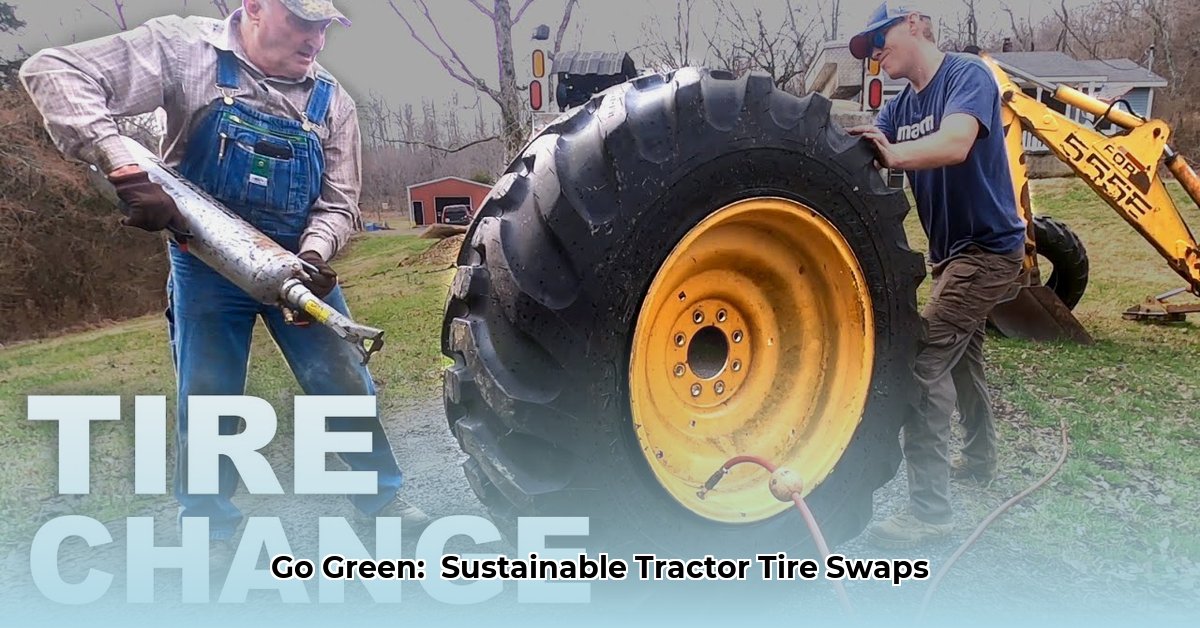
Keeping your tractor's tires in optimal condition is paramount for both economic and environmental sustainability. Proper tire maintenance minimizes fuel consumption, reduces soil compaction, and extends tire lifespan, decreasing waste and associated environmental impacts. This guide provides a comprehensive approach, from preventative maintenance to step-by-step tire replacement, emphasizing sustainable practices throughout. For detailed tire size information, check out this helpful resource: tractor tire sizes.
Preventative Maintenance: Maximizing Tire Lifespan
Proactive maintenance is the cornerstone of sustainable tire management. Regular inspections and care significantly extend tire life, reducing the need for frequent replacements and minimizing environmental impact.
Regular Tire Pressure Checks: Maintaining the correct tire pressure is critical. Underinflation increases fuel consumption and soil compaction, while overinflation leads to uneven wear and premature failure. Consult your tractor's manual for the recommended pressure and check regularly using a reliable gauge. Did you know that properly inflated tires can improve fuel efficiency by up to 10%?
Proper Weight Distribution: Uneven weight distribution stresses individual tires, causing premature wear. Ensure loads are evenly distributed across the tractor's axles to maintain balance and prolong tire life. Overloading is a common mistake, leading to significant tire damage and costly repairs.
Avoid Overloading: Never exceed your tractor's recommended weight capacity. Overloading significantly shortens tire lifespan and increases the risk of damage to the tractor itself. Always err on the side of caution: underloading is better than overloading.
Regular Tire Inspections: Regularly inspect tires for cuts, embedded objects (stones, metal), and excessive wear. Addressing minor issues promptly prevents them from escalating into major problems requiring costly replacements. A quick visual inspection before each use can head off serious issues.
Choosing the Right Tire: Selecting tires appropriate for your soil type and workload is crucial. Tires designed for soft, muddy conditions will perform poorly on hard, compacted soil. Selecting the right tire for each application maximizes both performance and longevity. Consider factors like tire size, load capacity, and tread pattern when making your selection.
Step-by-Step Tractor Tire Replacement
Replacing a tractor tire demands caution and the right tools. Safety is paramount throughout this process.
Safety Precautions: Before beginning, ensure your tractor is stable, the area is clear of obstructions, the parking brake is engaged, and the power take-off (PTO) is disengaged. Always use jack stands for support after lifting the tractor with a jack. Never work under a vehicle supported only by a jack.
Necessary Tools:
- Hydraulic Jack (or heavy-duty floor jack): A hydraulic jack rated for your tractor's weight is recommended.
- Breaker Bar or Pipe: Provides leverage for loosening stubborn lug nuts.
- Lug Wrench: Essential for removing and tightening lug nuts.
- Tire Mounting Tools (optional): Specialized tools are needed for mounting and dismounting tires; professional assistance is advisable for those unfamiliar with tire changing.
- Gloves and Safety Glasses: Protect hands and eyes from potential injury.
Step-by-Step Guide: (Simplified steps; variations may exist depending on your tractor and tire type. Consult your tractor's manual for specifics.)
- Complete Deflation: Completely deflate the tire for easier removal.
- Secure Lifting: Use the jack to carefully lift the wheel, ensuring it is securely supported by jack stands.
- Lug Nut Removal: Use the breaker bar to loosen, then remove the lug nuts.
- Wheel Removal: Carefully remove the wheel assembly from the axle.
- Tire Mounting (Professional Assistance Recommended): Unless you have experience, let a tire professional mount the new tire. This ensures correct installation and prevents damage.
- Wheel Remounting: Carefully align the wheel with the axle and install the lug nuts finger-tight.
- Carefully Lower the Tractor: Slowly lower the tractor using the jack.
- Lug Nut Tightening: Tighten the lug nuts in a star pattern to ensure even pressure.
- Inflation: Inflate the new tire to the manufacturer's recommended pressure.
- Responsible Disposal: Dispose of the old tire responsibly. Check your local regulations for recycling options. Many tire shops offer disposal services.
Sustainable Tire Practices: Minimizing Environmental Impact
The environmental impact of tire manufacturing and disposal is significant. Sustainable practices minimize this impact.
Maximize Tire Lifespan: Preventative maintenance is crucial. Extending tire life significantly reduces the need for replacements, conserving resources and reducing waste.
Responsible Tire Disposal: Old tires should never end up in landfills. Explore local tire recycling programs or repurposing options. Many municipalities have programs in place, providing solutions for disposal.
Sustainable Tire Materials: Research is ongoing to develop more environmentally friendly materials for tire production. Stay updated on advancements in this area.
Government Incentives and Regulations: Explore governmental incentives or regulations that promote sustainable tire management in your region. These programs often offer support for responsible disposal and the adoption of more environmentally friendly products.
Cost Savings: Investing in preventative maintenance and maximizing tire lifespan translates to significant long-term cost savings. The initial investment in care pays off in reduced replacement costs.
Conclusion: Investing in a Sustainable Future
Proper tractor tire maintenance isn't merely about avoiding breakdowns; it's a cornerstone of sustainable agriculture. By adopting preventative measures, performing replacements correctly, and prioritizing responsible disposal, farmers can contribute to a healthier environment while simultaneously enhancing their economic efficiency. The long-term benefits of this proactive approach are undeniable. The combination of financial savings and environmental stewardship make sustainable tire management a vital practice for responsible farming.